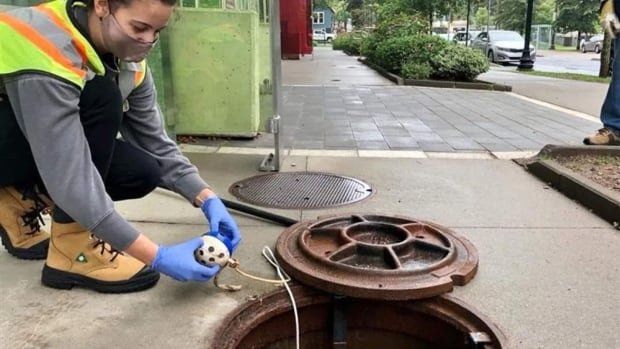Why scientists say wastewater surveillance needs to continue, despite low COVID-19 levels
Wastewater surveillance gained prominence in recent years by providing health officials with a summary of the degree of COVID-19 among Canadians during peaks in the pandemic. But its value beyond the coronavirus was quickly realized as a crucial public health tool. (CBC)Despite a majority of wastewater sites across the country reporting some of the lowest levels of COVID-19 since analysis began, some researchers say this type of surveillance should continue so Canada can be prepared for the next pandemic.Wastewater surveillance gained prominence in recent years by providing health officials with a summary of the degree of disease among Canadians during peaks in the pandemic. But its value beyond the coronavirus was quickly realized as a crucial public health tool that could help protect people from future harmful infections.Of the 39 sites tracked by Canada's COVID-19 wastewater surveillance dashboard, recent data shows that about 60 per cent are reporting decreasing levels of the viru


Despite a majority of wastewater sites across the country reporting some of the lowest levels of COVID-19 since analysis began, some researchers say this type of surveillance should continue so Canada can be prepared for the next pandemic.
Wastewater surveillance gained prominence in recent years by providing health officials with a summary of the degree of disease among Canadians during peaks in the pandemic. But its value beyond the coronavirus was quickly realized as a crucial public health tool that could help protect people from future harmful infections.
Of the 39 sites tracked by Canada's COVID-19 wastewater surveillance dashboard, recent data shows that about 60 per cent are reporting decreasing levels of the virus. The rest of the sites are stable or slightly lower than their previous readings.
"In the past, I would say, several weeks, we've seen a relatively consistent downward trend," said Dr. Guillaume Poliquin, vice-president of the National Microbiology Laboratory, part of the Public Health Agency of Canada (PHAC).
Wastewater reporting began in 2020, not long after the pandemic was declared by the World Health Organization, with more sites added as it continued.
Even though the amount of the virus at many of PHAC's sites appears to be at its lowest point since reporting began, Poliquin said it comes with a caveat.

"The techniques that are used, how accurate they are, how sensitive they are, has generally been getting better over time," he said.
"Monitoring has changed over time. It's not all the time comparable, but the trend is certainly reassuring."
It became apparent during the pandemic that COVID-19 levels will fluctuate based on the time of year. Disease spread tends to be lower in the warm summer months, with one reason being that people spend more time outdoors.
At the same time, 80.5 per cent of Canadians are fully vaccinated against the virus and more than 4.6 million have been infected, according to PHAC data — although its website notes that due to changes in testing, the number of cases might actually be higher.
How important is surveillance?
The practice of gathering wastewater from different communities and analyzing it for COVID-19 is a public health tool that researchers have said is useful to predict disease trends and support decisions around public health policies. But it's also a strong indicator of what's to come, as experts can see whether a new strain of the virus has emerged.
Initially, 21 per cent of Canada's population was being monitored, but it's now grown to more than 60 per cent across the country, Poliquin said.
Survey results published last month in The Lancet journal show that Canada was one of the top countries, among 43 that participated, whose wastewater surveillance efforts covered the majority of the population. The article goes on to emphasize how significant this sort of testing tool has proven to track current and emerging health threats.

Although the COVID-19 pandemic was recently downgraded from global emergency status, continued wastewater surveillance is still very important, said Eric Arts, Canada Research Chair in viral pathogenesis and control at Western University in London, Ont.
"It's too easy for the general public to see it and say, 'Well, [COVID-19] is no longer here, so why are we bothering with this?' And it's getting the information out that says ... 'You don't listen to the weatherman most of the time, but when you see a storm rolling in, you really wish you would have listened,'" Arts said in an interview with CBC News.
"It's preparing our health-care system for an impending wave."
Whether that's a new subvariant of COVID-19 or a range of other infectious diseases, Arts said advance warning could help the health-care system get ahead by rolling out protections and preventative measures.
Wastewater could indicate next pandemic
The federal government is also routinely monitoring wastewater for polio, mpox (formerly known as monkeypox), the flu and respiratory syncytial virus (RSV).
But Arts said he's most interested in using wastewater to get ahead of the unknown.
"[There are] new pathogens that might jump into the human population that we're not fully aware of," he said.
But if scientists don't know what they're looking for, how will they be able to tell it's in the wastewater?

"There's rapid advancement in technologies, and we can now monitor things that are novel and that are coming into the population, as long as we maintain these surveillance programs," he said.
Arts said he's part of a program that is looking at a way to monitor all of the possible strains of coronaviruses and influenza viruses that have the potential to infect humans.
"The tools we have at hand make the surveillance of those tens of thousands of strains actually not that difficult and not that cost prohibitive," he said.
"So when something does appear that shouldn't be in human wastewater, we can say, 'Hmm, that's something to keep an eye on,' and then alert the public health agencies."
Governments and health officials, he said, could prepare vaccines for these other possibly infectious strains and have them on hand to mass produce should a pandemic arise.
But there is some concern among those in the wastewater surveillance field that despite how essential this new technology is, monitoring could be cut if governments tighten their budgets.
Will monitoring continue?
The federal government's national wastewater monitoring system currently works with local researchers and labs to collect information from key sites. Additionally, some provinces and territories are funding their own efforts to monitor wastewater at a more local level.
At this time, there's no requirement for provinces to collect this data, nor is there any firm national strategy around a standardized procedure or collaborative database to hold this information.
Wastewater researchers are calling on Ottawa to create a national strategy that will consolidate this data and better inform the country's public health status.
While Poliquin, of the National Microbiology Laboratory, said he doesn't have a "definitive" answer on the next steps for this surveillance system, he told CBC News that ongoing conversations are taking place and work is being done to sustain and expand it.
"The technology has proven its value," he said. "There's a lot of potential here, and now that the network and infrastructure has been put in place, we are looking to continue to support it."
Poliquin said the scale of it is also cost-effective, with an individual PCR test costing $50 to $100 a person and a wastewater sample test costing $100 to $200.
In order for a national strategy to be effective, Arts said, the government needs to get all public health agencies on board, look at standardizing the procedure across the country and ensure that it consolidates the work out of specific centres.
Border surveillance top priority, say researchers
But if governments decide to scale back this type of warning system, researchers say it's most important to keep monitoring Canada's points of entry, such as borders and airports.
"Twenty-five to 30 per cent of Canada-U.S. trade crosses the border at Windsor-Detroit, making it the strategic location to place resources to be monitoring for diseases emerging in the country," said Mike McKay, executive director of the Great Lakes Institute for Environmental Research (GLIER) at the University of Windsor, in Windsor, Ont.

McKay, who has been monitoring the wastewater in southwestern Ontario and parts of the United States since the early months of the pandemic, said this type of surveillance will also help the private sector so that supply chains become more resilient.
He said GLIER is working alongside groups at the University of Guelph, University of Waterloo, York University and University of Toronto to pitch a cross-border surveillance program to the federal government.
This would include monitoring in Ohio, Michigan and into Windsor, as well as the Fort Erie, Ont., and Buffalo, N.Y., areas, he said.
The application will be submitted by September, and Ottawa is expected to to make a decision early next year. If accepted, the program would be part of a government-funded initiative around pandemic preparedness.
What's Your Reaction?























